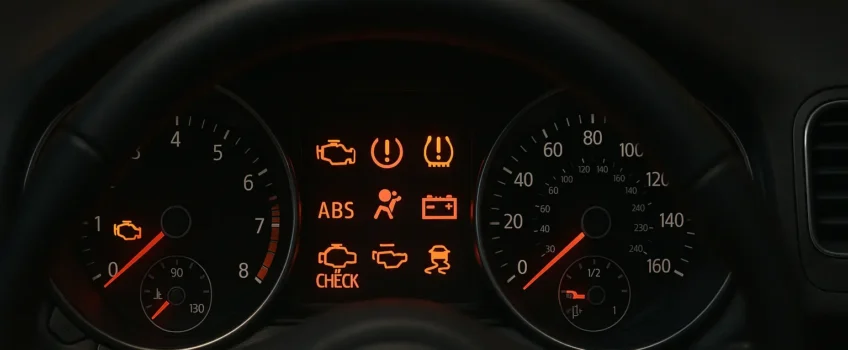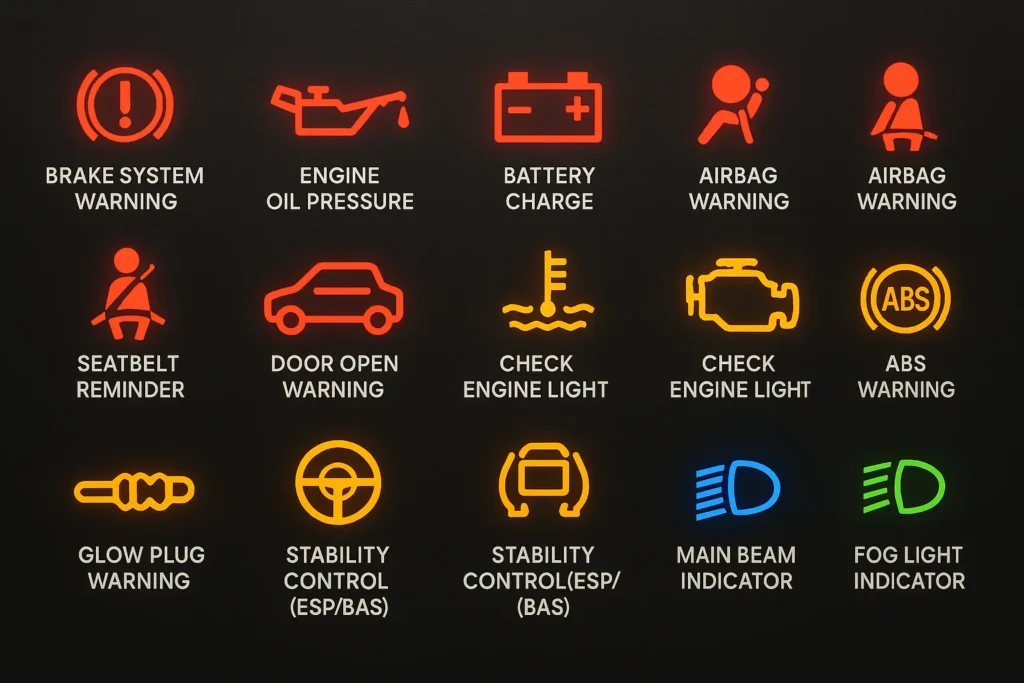
Dashboard Warning Lights: What They Mean and When to Act
We’ve all been there. You’re driving along as normal when suddenly — ping — one or more dashboard warning lights appear. Maybe it’s one you recognise, maybe it’s something unfamiliar. Either way, your heart skips a beat. Is it serious? Can you keep driving? Do you need to pull over right now?
The good news is, not all dashboard warning lights mean disaster. But they’re not there for decoration either. These warning signals are your car’s way of communicating, and ignoring them can sometimes turn a minor issue into a major repair.
In this guide, we’ll help you understand the most common dashboard warning lights, what they might mean, and when it’s time to get professional help like a quick trip to your nearest Elite Garages branch.
Understanding the Most Common Dashboard Warning Lights
Dashboard lights typically appear in three colours:
- Red: Urgent. Stop the car when safe and get help.
- Amber: Caution. You can often continue driving but should get it checked soon.
- Green/Blue: Information only (e.g. headlights on).
Let’s take a closer look at some of the key dashboard warning lights you’re most likely to encounter.
Engine Warning Light
This is one of the most common and most misunderstood dashboard warning lights. It can indicate anything from a loose fuel cap to a serious engine management fault. In some cases, it’s linked to emissions or misfires.
If left unchecked, certain engine issues (like a worn timing belt) could lead to serious damage. That’s why timely cambelt replacement is so important.
** Remember, if this light starts flashing, stop driving and get your car checked immediately.
Tyre Pressure Monitoring System (TPMS) Dashboard Warning Lights
This light usually looks like a flat tyre with an exclamation mark in the middle. It means one or more tyres has dropped below the recommended pressure, which affects fuel economy, braking, and safety. Visit Elite Garages for free tyre checks and a full range of car tyres if replacements are needed.
Brake System Dashboard Warning Lights
If this red light comes on while driving, it could mean low brake fluid or a fault with the braking system. Don’t take chances—book a brake service straight away.
Driving with faulty brakes can significantly increase your stopping distance, especially in wet or icy conditions. For more information on how car brakes work, common brake problems and when to replace them, read our Brake Masterclass.
Transmission or Gearbox Warning
This is often mistaken for the engine warning light, but it’s linked to your gearbox or clutch. If you’re noticing gear changes are sluggish, noisy or unresponsive, this light could confirm it’s time for a check-up.
Elite Garages is proud to be a clutch specialist, with decades of experience diagnosing and repairing manual and automatic clutch systems.
Battery or Charging Warning Light
This symbol tells you your battery isn’t charging properly—likely due to a faulty alternator or battery nearing the end of its life. If this light stays on, your car may not restart the next time you turn it off. At Elite, our advanced car diagnostics tools can quickly pinpoint the issue.
Why Some Dashboard Warning Lights Flash While Others Stay Solid
Flashing lights often indicate a more serious or immediate issue compared to a solid light. For example, a flashing engine warning light may suggest an active misfire that could damage your catalytic converter if not addressed quickly. Solid lights typically mean a fault has been detected, but not necessarily urgent.
Either way, if you’re not sure, it’s always best to err on the side of caution and get it checked.
Newer Cars, More Dashboard Warning Lights: What’s Changed?
With modern cars becoming smarter, there are now warning lights for systems many drivers haven’t seen before. These include:
- Lane assist malfunction
- Adaptive cruise control errors
- Parking sensor and blind-spot monitoring issues
- Hybrid or EV battery alerts
- Windscreen camera alignment problems
Many of these warnings stem from misaligned sensors—especially after a windscreen replacement or wheel alignment. Elite offers full ADAS calibration to ensure your vehicle’s safety features are accurate and responsive.
What Happens During a Professional Diagnostic Check?
When you book diagnostics at Elite Garages, you’re not just getting a quick scan. Here’s what happens:
- We connect your vehicle to professional-grade diagnostic software
- Our technicians interpret the fault codes—not just read them
- A visual inspection helps rule out simple fixes (e.g. loose wires or caps)
- You get a clear, jargon-free explanation of what’s wrong and what needs fixing
We’ll also check for related issues like wheel tracking, low brake fluid, or overdue cambelt replacement, helping prevent problems before they worsen.
It’s important to note that certain dashboard warning lights—such as those related to the engine, brakes, or airbags—can lead to an MOT failure if not addressed. According to the official MOT inspection manual, these systems must be in proper working order for your vehicle to pass the test.
What If There Are No Dashboard Warning Lights But Something Feels Off?
Not all faults trigger dashboard warning lights right away. If you’re experiencing any of the following, it’s still worth popping in to a professional garage:
- Clutch pedal feels strange or gear changes are sticky
- Car pulls to one side or steering feels vague
- Brakes feel soft or make unusual sounds
- A burning smell or strange engine noise
These signs could point to clutch issues, brake wear, or poor alignment—even if your dashboard stays quiet. Our technicians can spot what your dashboard hasn’t caught yet.
Can You Drive With a Warning Light On?
The short answer is: sometimes, but not always. The real question is whether it’s safe—or whether continuing to drive could cause more damage.
As mentioned earlier, red dashboard warning lights usually mean something serious is happening, such as a brake system failure, overheating engine, or low oil pressure. If you see a red light, pull over when it’s safe to do so and switch off the engine. Driving further could risk serious mechanical damage or compromise your safety.
Amber lights are often less urgent but still need attention. These include things like the engine management light or tyre pressure warning. You can usually keep driving for a short distance, but it’s best to get your car checked as soon as possible.
When in doubt? Don’t risk it.
If a light has appeared and you’re unsure what it means, visit your nearest Elite Garages car service centre. Our technicians will run quick checks and let you know what’s safe, what needs fixing, and what can wait.
Final Thoughts: Let the Light Guide You (But Let Us Do the Fixing)
Dashboard warning lights are like your car’s early warning system—and knowing what they mean can save you time, stress, and unnecessary repair bills. But you don’t have to decode them alone.
Whether it’s a battery issue, brake warning, tyre alert, or something more complex, Elite Garages is here to help. With our modern diagnostic tools and decades of experience, we’ll get to the root of the problem quickly and affordably.
FAQS: Dashboard Warning Lights
Click the + to read any answer or visit our most FAQ page to review the most frequently asked questions across all our Elite Locations.
If you click on a ‘Category’ or ‘Tag’ link, the page will ‘refresh’ and reload the page showing the top of the page first, you’ll then just need to scroll down to the FAQ section to see the results for the Category or Tag you selected.
The most serious dashboard warning lights are typically red and indicate issues that could put your safety—or your engine—at risk. These include the brake system warning light, engine oil pressure warning, coolant temperature warning, and the airbag or SRS warning. If any of these lights appear while driving, you should stop the car as soon as it’s safe and seek professional assistance. Ignoring them can lead to breakdowns, serious damage, or compromised safety systems.
Yes, some can be reset manually, but if the underlying fault isn’t fixed, the light will return. DIY resets can also mask more serious issues, so professional diagnostics are always recommended.
One of the most common reasons for the check engine light to come on is a faulty oxygen sensor, which affects how your engine manages fuel and emissions. Other frequent causes include a loose fuel cap, failing catalytic converter, or issues with ignition coils or spark plugs. While it’s not always serious, the check engine light should never be ignored—an expert diagnostic check will pinpoint the exact cause and prevent bigger problems later.
About Us
Opening Times
Saturday : 8:30–4:00
Sunday : closed
More Information
Contact UsCustomer Information Pack
Check MOT Due Date
Free MOT reminder
Careers
Legal Information
Recent Posts
- MOT in Dorchester: Keeping the South Coast Safely on the Move
- Car Battery Problems: Don’t Let a Dead Battery Flatten Your Day
- Bridgestone Tyres Promotion: Free Gift and Enter to Win £5,000
- Is Your Car Air Conditioning Ready for Autumn and Winter?
- Beyond Your Fareham MOT Centre: Tyres, Servicing, and Safety Checks



